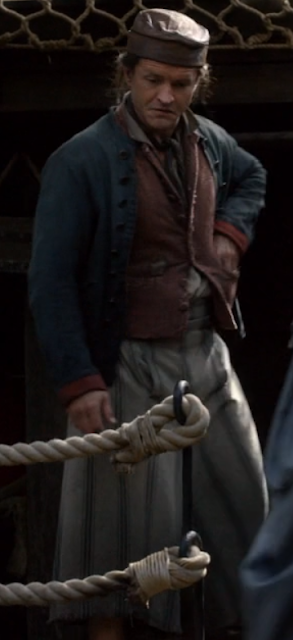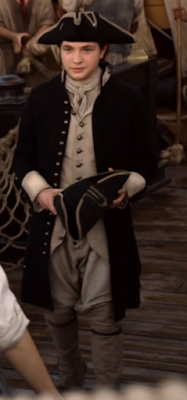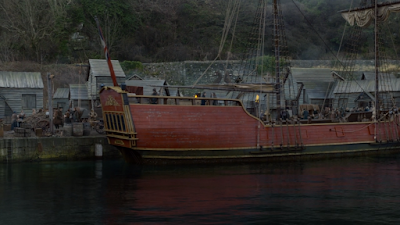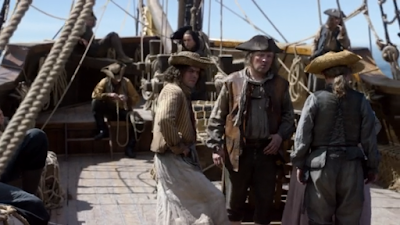 |
| Detail from Admiral Hosier's Ghost, Charles Mosley, 1740, John Carter Brown Library of Early American Images. |
Sailors in the mid to late eighteenth century did sometimes hold beliefs we would recognize as relatively secular superstitions, but more commonly they held a supernatural view of the world in which God directly intervened based on their personal actions.
In their memoirs and journals, sailors rarely mention explicit superstitions. When they do, it is often with an air of disdain. Samuel Kelly related the story of a pilot's belief that the ship's cat could predict (or perhaps effect) the weather:
Having got the pilot on board at Deal and some fresh provisions, we sailed for the river. Our pilot, seeing our cat frolicsome, who doubtless smelled the land, and was running in and out on the bowsprit, became exasperated against the poor animal; he being superstitious concluded her gambols denoted a heavy gale of wind, which actually came on and we rode out the storm in Margate Roads, but I do not think the manoeuvres of the cat were in any way connected with it.[1]
Sean M. Kelley, in his Voyage of the Slave Ship Hare, points to a form of superstition specific to mariners from the colony of Rhode Island: horoscopes.
There is also evidence that sailors repeated superstitions, but didn't really believe them. William Spavens seemed to think that superstitions were harmless fun when he wrote of albatrosses 'we used to say they were old transmigrated pursers, &c.'[4] Kelly made game of a cabin boy by intentionally misleading him to believe Kelly possessed the power of telling the future:
By the mid-eighteenth century, the practice of astrology in England had declined to the point where it existed only in popular form among the rural and urban laboring classes. But for unclear reasons, it persisted in colonial America, and for reasons that are even murkier, all surviving maritime horoscopes come from Rhode Island.[2]And there is evidence that others saw sailors as superstitious as well. In The Gentleman's Magazine for 1771, the author relates the tale of a Chinese visitor to Britain who sailed on the Grenville East Indiaman. 'Mr. Chitqua,' as the authors of the magazine called him, discovered that the common sailors were unaccountably prejudiced against him ; owing, probably, to his strange dress and appearance.' This was made worse, they wrote, to his falling overboard and nearly drowning. The sailors with 'superstitious fears...like those of Tarshish' turned against Mr. Chitqua and denounced him as a 'Chinese dog.'[3] How much of this was genuine superstition and how much was just base racism is a matter of speculation.
There is also evidence that sailors repeated superstitions, but didn't really believe them. William Spavens seemed to think that superstitions were harmless fun when he wrote of albatrosses 'we used to say they were old transmigrated pursers, &c.'[4] Kelly made game of a cabin boy by intentionally misleading him to believe Kelly possessed the power of telling the future:
One evening, sitting alone writing in the cabin, I heard a rat at work in the locker, when having looked therein, I saw a rat with one eye shut, eating the cork of an oil jar. Soon after I heard him again. I therefore called the cabin boy and told him to hold the candle that I might kill the rat he heard in the locker, and in order to make the boy be more afraid of doing anything amiss, I gave him to understand that I could discover many things, and as proof of it that I knew the said rat had but one yes. I then (with the poker) opened the locked an killed the rat, which I told the boy to examine, and he was not a little surprised at finding my report true.[5]
Though Kelly obviously didn't believe he had accurate premonitions, it was a common belief among sailors. Olauadah Equiano related a story in which his vessel's quarter gunner, John Mondle, woke from a nightmare 'in which he said he had seen many things very awful, and had been warned by St. Peter to repent.' Duly selling off his hard liquors, Mondle was rewarded when 'before Mr. Mondle had got four steps from his cabin-door, [a vessel] struck our ship with her cutwater right in the middle of his bed and cabin, and ran it up to the combings of the quarter-deck hatchway, and above three feet below water, and in a minute there was not a bit of wood to be seen where Mr. Mondle's cabin stood.' Equiano saw this 'as an awful interposition of Providence for his preservation.'[6]
In this anecdote we see an intersection between superstition and religion: a belief in the direct and immediate intervention of God (and Saint Peter) into the lives of sailors based on their behavior.
To be clear, sailors do not appear to have been traditionally Christian. Church services for sailors at sea were rare, and sailors do not appear to have been particularly interested in keeping up with their daily prayers and reading the Bible. John Nicol fell away from his religious observance rather quickly when he first put to sea:
The gunner of the Wager, a sailor named Bulkeley, was quoted by Brian Lavery in his Royal Tars: The Lower Deck of the Royal Navy, 875-1850, echoed the lack of regular religious services at sea:
Marcus Rediker, in his Between the Devil and the Deep Blue Sea: Merchant Seamen, Pirates, and the Anglo-American Maritime World, 1700-1750 put it this way:
An excellent example of this was related by Olauadah Equiano:
Sailors could also influence the Almighty and ask for His intervention. John Harrower, a servant being shipped to America in 1773, related an incident that straddled the line between superstition and religious practice in supplications to Christ:
In this anecdote we see an intersection between superstition and religion: a belief in the direct and immediate intervention of God (and Saint Peter) into the lives of sailors based on their behavior.
| Detail from Poor Jack, Charles Dibdin, 1790-1791, British Museum. |
At first I said my prayers and read my Bible in private, but truth makes me confess I gradualy became more and more remiss, and before long I was a sailor like the rest; but my mind felt very uneasy and I made many weak attempts to amend.[7]
John Newton similarly lost his faith at sea:
I was exposed to the company and ill example of common sailors, among whom I ranked. Importunity and opportunity presenting every day, I once more began to relax from the sobriety and order which I had observed, in some degree, for more than two years. I was sometimes pierced with sharp convictions; but though I made a few faint efforts to stop, I never recovered from this declension, as I had done from several before: I did not, indeed, as yet, turn out profligate; but I was making large strides towards a total apostacy from God.[8]
Despite being raised in a strictly traditional Christian household in New England, Christopher Prince also lost his religious habits after a short time afloat:
I soon began to neglect my morning and evening prayers which I had strictly attended to for five years.[9]
Samuel Kelly later expressed regret over not attending church when he had the opportunity to:
Instead of frequenting a place of worship on Sundays to return thanks for the numberless mercies I had experienced during my voyage, I spent the Sabbath in wandering about and in paying visits.[10]
Ebenezer Fox would also later 'regret that I did not spend the Sabbath on board of the Flora,' where he would presumably read his Bible and pray, but was instead 'carousing at a public house on shore.'[11]
The gunner of the Wager, a sailor named Bulkeley, was quoted by Brian Lavery in his Royal Tars: The Lower Deck of the Royal Navy, 875-1850, echoed the lack of regular religious services at sea:
The duty of public prayer had been entirely neglected aboard, though every seaman pays fourpence per month towards the support of a minister; yet devotion, in so solemn a manner, is so rarely performed that I know but one instance of it during the many years I have belonged to the navy.[12]The lack of religious ceremony, ritual, and prayer afloat does not appear to have always been the case. Peter Earle wrote 'that religious observance was not unusual on merchant ships, though regular prayers may well have been commoner in the seventeenth than in the eighteenth century.'[13]
Marcus Rediker, in his Between the Devil and the Deep Blue Sea: Merchant Seamen, Pirates, and the Anglo-American Maritime World, 1700-1750 put it this way:
The ship was an environment where work, activity, and self-help necessarily took precedence over religious mediation or supplication. Religious belief and practice had to be broadly congruent with the imperative of work and survival. This necessity, reinforced by the ship's isolation and distance from religious institutions, joined with long-standing plebian traditions of skepticism and anticlericalism to make sailors one of the most notoriously irreligious groups of the early modern period.[14]John Nicol typified this attitude when he wrote:
The Portuguese are the worst sailors in the world in rough or cold weather, and we had plenty of both, but worse than all we had a black fellow of a priest on board to whom the crew paid more attention than the captain. He was forever ringing his bell for mass and sprinkling holy water upon the men. Whenever it blew harder than ordinary they were sure to run to the quarterdeck to the black priest. We were almost foundered at one time by this unseamanlike conduct.[15]
To Nicol, the Portuguese praying with a priest and engaging in the sacraments instead of working to change their fate was 'unseamanlike conduct.'
Sailors were irreligious in the traditional Christian sense, but that doesn't mean they were agnostic or atheistic. They did still believe that God (or providence, or a similar permutation) would directly and immediately intervene and punish or reward them for their actions. Once a situation was out of the control of sailors, they then resorted to prayer. Kelly thought this attitude understandable, but fickle:
I have read somewhere that seamen are neither reckoned among the living nor the dead, their whole lives being spent in jeopardy. No sooner is one peril over, but another comes rolling on, like waves of a full grown sea. In the Atlantic one fright after another undermines the most robust constitution and brings on apparent old age in the prime of life. No trouble softens their hard obdurate hearts, but as soon as the danger is past they return in the greatest avidity to practice wickedness and blaspheme their Maker and preserver.[16]William Spavens reflected this same thought when he observed:
I have somewhere seen it observed, that when sailors are in such distress that they have scarcely any hopes of saving their lives, they will curse the elements, go to prayer, and make the most solemn vows of amendment, which are generally forgotten as soon as the tempest is over; but, to the honour of my brother tars, I can truly assert that I have met with many humane and worthy characters in the service, who I have reason to suppose were neither wanting in their duty to their God nor their fellow creatures.[17]Spavens did not deny that sailors acted in a fashion seen as irreligious for their time, nor did he deny that they would drop to their knees in prayer when disaster threatened only to revert to their old ways immediately afterward. Still, he defended them as 'humane and worthy characters.' This is completely in line with the sailors' view of the direct and immediate intervention of God based on their actions.
An excellent example of this was related by Olauadah Equiano:
While I was in this ship an incident happened, which though trifling, I beg leave to relate, as I could not help taking particular notice of it, and considering it then as a judgment of God. One morning a young man was looking up to the fore-top, and in a wicked tone, common on shipboard, d----d his eyes about something. Just at the moment some small particles of dirt fell into his left eye, and by the evening it was very much inflamed. The next day it grew worse; and within six or seven days he lost it.[18]John Newton similarly saw God's hand in choosing who lived and who died:
I have been told, that he was overtaken in a voyage from Lisbon with a violent storm; the vessel and people escaped, but a great sea broke on board, and swept him into eternity. Thus the Lord spares or punishes according to his sovereign pleasure![19]Christopher Prince thought God chose to spare his vessel and its entire crew because of Prince alone:
The kind interposition of Divine Providence brought to my mind many others that had brought me within a hair's breadth of death: and one was in a voyage once to St. Lucé, where I fell from the upper deck of a large brig into the bottom of the hold, one tier of hogsheads excepted, in a dark night, and all hands asleep. There was a protecting hand of the Almighty which saved me from death, although I was in the arms of death for some time.[20]Kelly also saw the hand of God in his preservation ('What a mercy it is that an elect sinner cannot lose his life till he has experienced the grace of effectual calling') and in the punishment of sinners ('As my uncle was a very moral, prudent man, I cannot account for his losses as anything so much as from the property being obtained in the slave trade').[21]
Sailors could also influence the Almighty and ask for His intervention. John Harrower, a servant being shipped to America in 1773, related an incident that straddled the line between superstition and religious practice in supplications to Christ:
This morning a young lad, one of the servts being verry ill with the Fever and Ague, he begged me to apply to Mr. jones the Cheif Mate, and told me he cou'd give him something that would cure him; Mr. Jones first desired me to give him a Womite and then wrote the following lines on a slip of paper and after folding it up gave it to me, to see it tyed up int he corner of his handkirchif or Cravat and wear it at his breast next his skin with strick charge not to look at it himself nor let any other person see it or look at it untill it was got wel. The words are as follows When Jesus saw the Cross he trembled, The Jews said unto him why tremblest thou, You have neight got an Ague nor a fever. Jesus Answered and said unto them I have neight got an Ague nor a fever But whosoever keepth my words Shall neither have an Ague nor a fever. Mr. Jones told me when he gave me the above copy it a sertain cure for the fever and Ague, the patient being first womited and then wearing the lines as above directed, But if they show it to any or look at it themselves it will have no effect.[22]A similar intersection of religion and superstition came from the belief that Friday was an ill omen, as it was this day that Christ was crucified. Christopher Prince, writing after he had left the sea and became a religious reformer, believed he had proof against it:
We arrived safe at New London, only eight days absent, and brought Mr. Mumford not less than $40,000 worth of property, equal to silver and gold. The success throwed away the superstition of many about a vessel sailing on a Friday.[23]
Sean M. Kelley points to Rhode Island sailors' practice of casting horoscopes as another example of the mutual existence of superstition and Christianity:
Ultimately, the line between religion and superstition is a blurry one. The very root of superstition is in the Latin word meaning 'prophecy, soothsaying; dread of the supernatural, excessive fear of the gods, religious belief based on fear or ignorance and considered incompatible with truth or reason.'[26] This definition is broad enough that it can be imposed by any religious belief onto another. Sailors were irreligious in the eyes traditional terrestrial Christianity. Whether that translates to superstition is dependent very much on your own religious belief.
While most clergy would have frowned upon astrological conjuring, practitioners often found ways to reconcile it with formal religion. The system was open enough to allow practitioners to elide any conflicts.[24]It is worth noting that Olauadah Equiano, Christopher Prince, and John Newton, all men who served as common sailors and later wrote memoirs, became active religious reformers when they retired from the sea. Samuel Kelly likewise went on to become a fervent traditional Christian, though you might not know it from reading his published journal. As Stephen R. Berry related in his A Path in the Mighty Waters: Shipboard Life & Atlantic Crossings to the New World:
The nearly unanimous conception of sailors as irreligious sometimes downplayed contrary evidence, to the point of excising religion from texts. The early twentieth-century editor of mariner Samuel Kelly's journal expunged the "disease" of "psalm-singing" and moralizing from the diary, acting on the conviction that these traits had little to do with life at sea. For Kelly, however, those things had everything to do with the sea.[25]The memoirs of Kelly, Equiano, Prince, and Newton are all colored by their later religious fervor, and conformity to a terrestrial Christianity that may not have been as prominent at sea. Or, as Berry argues, it may have 'had everything to do with the sea.'
Ultimately, the line between religion and superstition is a blurry one. The very root of superstition is in the Latin word meaning 'prophecy, soothsaying; dread of the supernatural, excessive fear of the gods, religious belief based on fear or ignorance and considered incompatible with truth or reason.'[26] This definition is broad enough that it can be imposed by any religious belief onto another. Sailors were irreligious in the eyes traditional terrestrial Christianity. Whether that translates to superstition is dependent very much on your own religious belief.
---
[1] Kelly, Samuel, Samuel Kelly: An Eighteenth Century Seaman, Whose Days Have Been Few and Evil, edited by Crosbie Garstin, Frederick A. Stokes Company, 1925, pages 159-160.
[2] Kelley, Sean M., Voyage of the Slave Ship Hare: A Journey into Captivity from Sierra Leone to South Carolina, Chapel Hill: University of North Carolina, 2016, page 46.
[3] The Gentleman's Magazine, vol. 41, 1771, page 237, University of Michigan via HathiTrust Digital Library, accessed January 7, 2019, <https://babel.hathitrust.org/cgi/pt?id=mdp.39015018405400;view=1up;seq=285>.
[4] Spavens, William, Memoirs of a Seafaring Life: The Narrative of William Spavens, edited by N.A.M. Rodger, County Somerset: The Bath Press, 2000, page 72.
[3] The Gentleman's Magazine, vol. 41, 1771, page 237, University of Michigan via HathiTrust Digital Library, accessed January 7, 2019, <https://babel.hathitrust.org/cgi/pt?id=mdp.39015018405400;view=1up;seq=285>.
[4] Spavens, William, Memoirs of a Seafaring Life: The Narrative of William Spavens, edited by N.A.M. Rodger, County Somerset: The Bath Press, 2000, page 72.
[5] Kelly, Eighteenth Century Seaman, page 141.
[6] Equiano, Olaudah, The Interesting Narrative and Other Writings, edited by Vincent Carretta, New York: Penguin, 2003, page
[7] Nicol, John, The Life and Adventures of John Nicol, Mariner, edited by Tim Flannery, New York: Atlantic Monthly Press, 1997, page 28.
[8] Newton, John, The Works of the Rev. John Newton, Late Rector of the United Parishes of St. Mary Woolnoth and St. Mary Woolchurch Haw, London, Volume 1, New Haven: Nathan Whiting, 1824, page 18.
[9] Prince, Yankee Mariner, page 15.
[10] Kelly, Eighteenth Century Seaman, page 130.
[11] Fox, Ebenezer, The Adventures of Ebenezer Fox in the Revolutionary War, Boston: Charles Fox, 1847, page 213-214.
[12] Rediker, Marcus, Between the Devil and the Deep Blue Sea: Merchant Seamen, Pirates, and the Anglo-American Maritime World, 1700-1750, New York: Cambridge University Press, 1987, page 169.
[13] Lavery, Brian, Royal Tars: The Lower Deck of the Royal Navy, 875-1850, Annapolis: Naval Institute Press, 2010, page 176.
[14] Kelly, Eighteenth Century Seaman, page 138.
[15] Earle, Peter, Sailors: English Merchant Seamen 1650-1775, London: Methuen, 2007, page 105.
[16] Nicol, Life and Adventures, page 148.
[17] Spavens, Memoirs, 26
[18] Equiano, Interesting Narrative, page
[6] Equiano, Olaudah, The Interesting Narrative and Other Writings, edited by Vincent Carretta, New York: Penguin, 2003, page
[7] Nicol, John, The Life and Adventures of John Nicol, Mariner, edited by Tim Flannery, New York: Atlantic Monthly Press, 1997, page 28.
[8] Newton, John, The Works of the Rev. John Newton, Late Rector of the United Parishes of St. Mary Woolnoth and St. Mary Woolchurch Haw, London, Volume 1, New Haven: Nathan Whiting, 1824, page 18.
[9] Prince, Yankee Mariner, page 15.
[10] Kelly, Eighteenth Century Seaman, page 130.
[11] Fox, Ebenezer, The Adventures of Ebenezer Fox in the Revolutionary War, Boston: Charles Fox, 1847, page 213-214.
[12] Rediker, Marcus, Between the Devil and the Deep Blue Sea: Merchant Seamen, Pirates, and the Anglo-American Maritime World, 1700-1750, New York: Cambridge University Press, 1987, page 169.
[13] Lavery, Brian, Royal Tars: The Lower Deck of the Royal Navy, 875-1850, Annapolis: Naval Institute Press, 2010, page 176.
[14] Kelly, Eighteenth Century Seaman, page 138.
[15] Earle, Peter, Sailors: English Merchant Seamen 1650-1775, London: Methuen, 2007, page 105.
[16] Nicol, Life and Adventures, page 148.
[17] Spavens, Memoirs, 26
[18] Equiano, Interesting Narrative, page
[19] Newton, Works, page
[20] Prince, Yankee Mariner, page 92
[21] Kelly, Eighteenth Century Seaman, pages 88 and 133.
[22] Harrower, John, "Diary of John Harrower, 1773-1776," in The American Historical Review, Volume 6, No. 1, October 1900, page 75, via Internet Archive, accessed February 3, 2018, <https://archive.org/stream/jstor-1834690/1834690#page/n11/mode/2up>.
[20] Prince, Yankee Mariner, page 92
[21] Kelly, Eighteenth Century Seaman, pages 88 and 133.
[22] Harrower, John, "Diary of John Harrower, 1773-1776," in The American Historical Review, Volume 6, No. 1, October 1900, page 75, via Internet Archive, accessed February 3, 2018, <https://archive.org/stream/jstor-1834690/1834690#page/n11/mode/2up>.
[23] Prince, Christopher, The Autobiography of a Yankee Mariner: Christopher Prince and the American Revolution, edited by Michael J. Crawford, Washington, D.C.: Brassey's Inc., 2002, page 160.
[24] Kelley, Slave Ship Hare, 48.
[25] Berry, Stephen R., A Path in the Mighty Waters: Shipboard Life & Atlantic Crossings to the New World, New Haven: Yale University Press, 2015, page 89.
[26] 'superstition, n,', Online Etymological Dictionary, accessed February 22, 2018, <https://www.etymonline.com/word/superstition>.
[24] Kelley, Slave Ship Hare, 48.
[25] Berry, Stephen R., A Path in the Mighty Waters: Shipboard Life & Atlantic Crossings to the New World, New Haven: Yale University Press, 2015, page 89.
[26] 'superstition, n,', Online Etymological Dictionary, accessed February 22, 2018, <https://www.etymonline.com/word/superstition>.





















